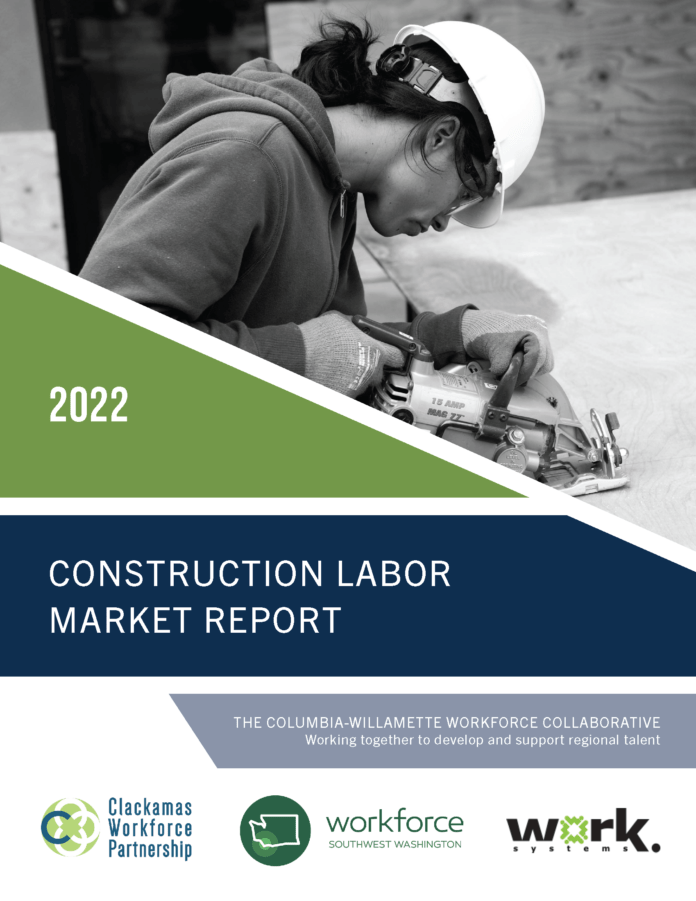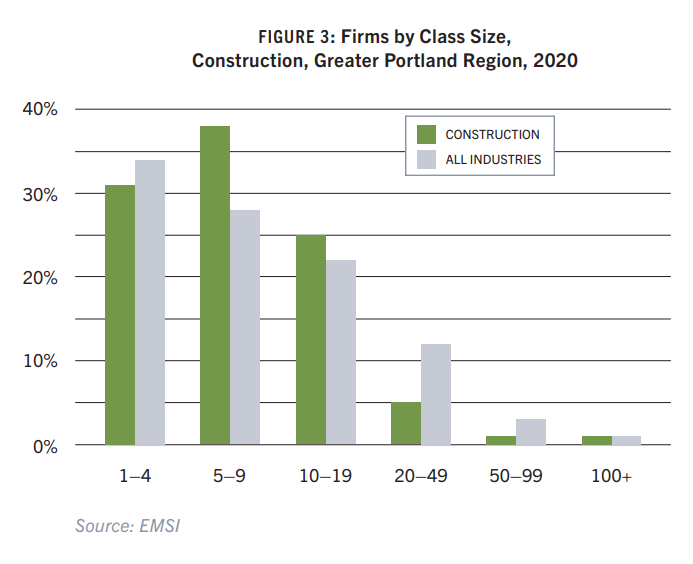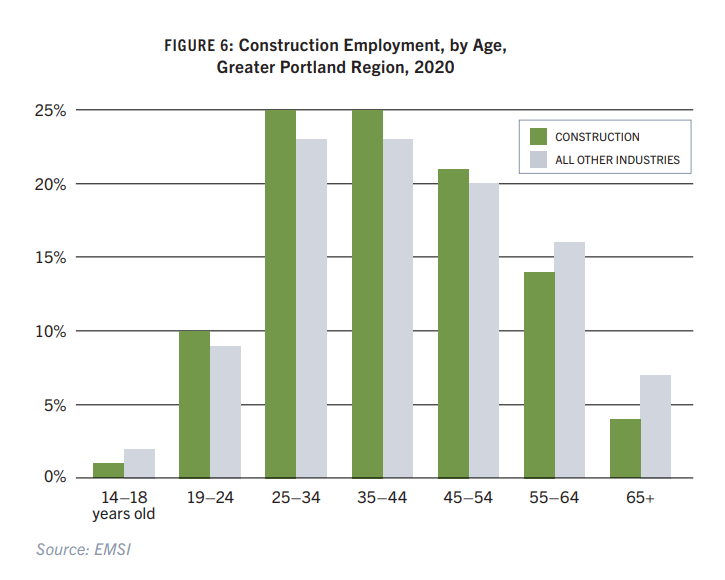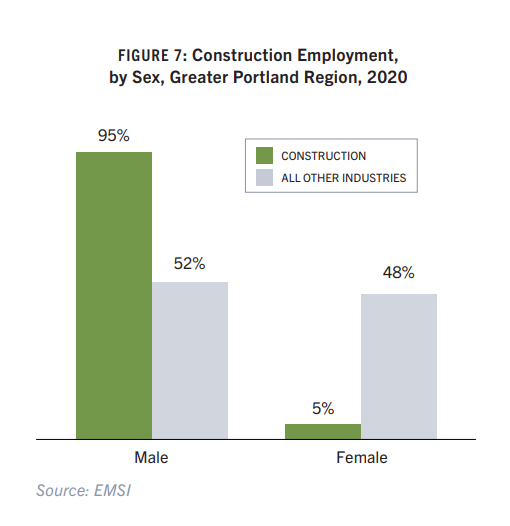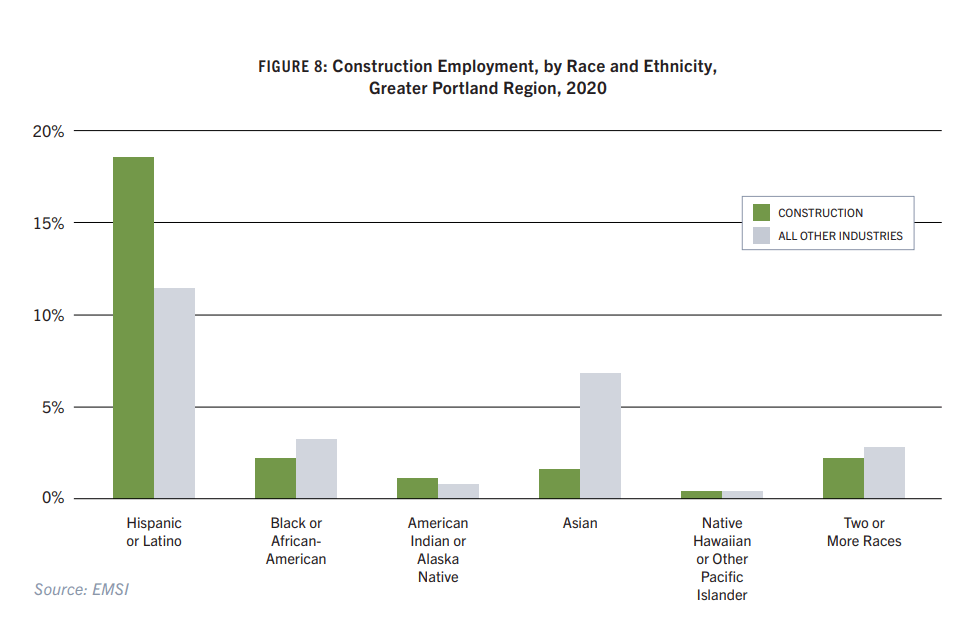With more than 77,000 jobs and a payroll of $6.8 billion, construction accounts for nearly 7% of the Southwest Washington-Portland Metro area’s private-sector employment and 7% of payroll. The sector contributed approximately $7.9 billion to the area’s Gross Domestic Product in 2020.
Construction is one of four key industries supported by the local public workforce system and the workforce development board, Workforce Southwest Washington (WSW), which recently released an updated Construction Labor Market Report.
A few highlights from the new report include:
Company Size
The region is home to roughly 9,600 construction establishments. The average size of a construction firm is slightly smaller than for all firms: 10 employees per company versus 15 overall.
Approximately 64% of the region’s construction employment is in companies with fewer than 20 people.
In my experience, many contractors find new workers by word of mouth and employee referrals. Anecdotally speaking, the construction industry does not advertise job openings via the popular online job boards or through community-based organizations at the same rate as other industries. Job candidates who might be new to the industry do not have a place to go to make those professional connections unless they are fortunate enough to know someone who works in the field. That cycle is a reason getting into the construction industry can be challenging for job applicants from historically excluded populations – the very people many contractors want to attract.
What do we do about it?
- To reach the next generation of workers, contractors can connect directly to high school career and technical education (CTE) programs or work with high schools to connect with students who aren’t yet on a career path and introduce them to the construction trades.
- Contractors can begin to use online job boards, their websites, social media and the vast array of community-based organizations that are connected to the applicants they seek to attract.
- Proceed to the next section on worker demographics for critically important recruitment and retention strategies.
Worker Demographics
Current and future building trends, both public and private, are rapidly increasing the demand for skilled tradespeople. While the construction workforce is slightly younger than the total workforce, nearly one-fifth of the region’s construction workers are age 55 or older and nearing retirement.
Although the number of people completing apprenticeship programs in construction occupations like electricians, laborers and carpenters has steadily increased over the past decade, the numbers remain well below what is needed to satisfy industry demand.
The construction sector is overwhelmingly male with 95% of the workforce compared to 52% for all other industries.
Workers who identify as white are 74% of both the total workforce and the construction workforce in the Southwest Washington-Portland region.
Workers who identify as Hispanic comprise a greater share of the workforce compared to all other industries, while workers who identify as Black, African American and Asian are underrepresented in construction.
Recognizing the historic underrepresentation of people of color and women, the construction industry has adopted and is committed to increasing diversity as a primary goal as outlined in the 2021-2023 Construction Workforce Plan.
The plan’s strategies include:
- Create trusted relationships that promote success for diverse workers in construction
- Develop robust marketing strategies highlighting diversity
- Allocate resources for pre-apprenticeship, training, screening capacity, and support for women and people of color
- Incorporate best practices that institutionalize diversity
If you are interested in joining this shared table to advance these equity strategies, please reach out to me. It is imperative that the construction sector is prepared to welcome, train and support a more diverse workforce.
Education
Nearly eight out of every 10 construction jobs do not require education beyond a high school diploma.
Thirty-two construction trades, accounting for 55% of all construction jobs in the greater region, are accessible by completion of a registered apprenticeship. Only 15% of construction jobs call for an associate degree or higher; a significantly smaller proportion than for all other industries (30%).
Wages
In Washington, 50% of construction workers earn $34 per hour or more.
I probably don’t need to state the obvious, but I will anyway – what a recruiting tool! Bring your high school diploma/equivalent and come work in an industry that provides paid on-the-job training and advancement opportunities!
COVID Aftermath
Construction experienced a slight dip during the COVID-19 recession but was less impacted and recovered more quickly than other sectors. The industry is expected to add more than 13,200 jobs over the next decade, a growth rate of 17%.
Resources for Businesses
To meet the region’s construction needs, companies must attract more workers, especially women, people from historically underrepresented communities and younger workers.
To ensure workforce development strategies adapt as the industry and its needs change, WSW and its regional partners meet with construction and related-industry firms quarterly. If you would like to participate, lend your voice, be involved and learn about grant funds and other resources, contact me or visit the construction page of WSW’s website for dates.
WSW and the workforce system have numerous resources available to help construction and related companies. I am here to support you and would be happy to review opportunities with you and help your organization craft a strategy to attract, train and retain a qualified and skilled workforce that is ready to fill your open positions now and in the future.
Workforce Southwest Washington (WSW), a nonprofit organization, is the Local Workforce Development Board (LWDB) designated by federal Workforce Innovation and Opportunity Act (WIOA) legislation to oversee the public workforce system in Cowlitz, Wahkiakum and Clark counties.
Darcy Hoffman is the director of business services at Workforce Southwest Washington. She can be reached at dhoffman@workforcesw.org or 360-608-4949.



